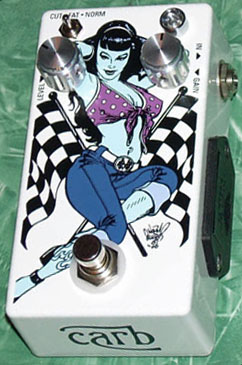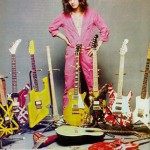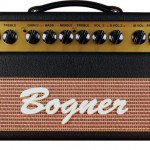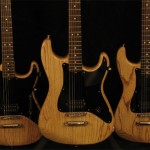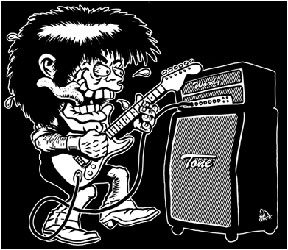The Best Stompbox I’ve Ever Owned (Part 1)
The Gaspedals Carb!
What if a stompbox gave you only two things: more and better. More of the tone you worked hard at creating for yourself, then opening that up with more clarity, dynamics, harmonics and whatever other descriptors you want to toss in there that equal better to you. Would you jump all over it?
Of course you – a diehard tone knucklehead – would! And you can. You CAN take $225 of your hard-earned, probably scarce cash and buy more and better. And you should. I’m telling you: It’s that freakin’ good!
Okay, what am I talking about? The Gaspedals Carb.
It’s a stompbox. It adds volume and “gain,” but isn’t a boost pedal, isn’t a distortion box, isn’t an overdrive, isn’t a preamp, isn’t a fuzz, isn’t an EQ, etc. – at least not to my ears. It also does not compress or in any way alter the EQ or tone of your signal. It just makes your signal and you sound better.
I understand that is a somewhat lame, though interesting, “explanation” – which is why I interviewed Gaspedals owner and Carb creator Jayson Lane about it. He had the vision for creating this box of luscious tone goodness, so why not let him describe it?
But first, here’s how I got onto it. Two words: Joe Bonamassa. The Carb was a regular member of his pedal board, and I heard about it and heard it in a video about his rig (the first vid in this post, starting at 5:24 – dig the sweet feedback).
Tough to hear a whole lot on compressed Internet video, but my ears perked up right away – and if you go on harmonycentral.com and read about the Carb, people have had similar experiences.
Joe calls it “kind of a cross between a Fuzz Face and a clean boost.” I call it the best stompbox I’ve ever heard. Jayson calls it the Carb. More from Jayson follows – but first a quick disclaimer: I am NOT a big stompbox guy, especially when it comes to overdrive, distortion or fuzz boxes. I have one fuzzbox just for messing around once in a while, but I much prefer to get “natural” distortion from an amp. So please bear my lack of signal-clipping stompbox expertise in mind.
WoodyTone:Â I can’t explain what this pedal does. The only word that comes to mind is “more,” as in “better everything.” Maybe “bloom?” It just makes everything sound better. In fact, it makes my sound sound the best I’ve ever heard it. So help me out here:Â Can you please describe what this pedal does?
Jayson: I’d say it adds gain and does so in a way that does not detract from the dynamics of your guitar strings. In addition it adds a subtle exciter of sorts which kind of makes things come alive. Harmonically it just gets people’s ears and attention perked up a bit while giving you a bit of a kick in the ‘grundle.’
What is it designed to do?
It was really designed for a gigging situation. I built it when I was gigging and wanted it to work for that situation. Since a cooking tube amp is already compressing, I find adding compression with overdrive can get dull.
Also, people love them some bass – turn up the bass! Yes it’s cool when you’re jamming along by yourself, but I find too much bass in your guitar signal, especially the overdriven tone, can cause a muddy mix as it fights with bass guitar and kick drum frequencies. I didn’t want the bass to go away like a Rangemaster does. I wanted to accentuate frequencies that would bring the guitar forward in the mix without having to boost a lot of volume, which also can cause problems on stage.
Your website says the Carb “was designed to give you the sweet and crunchy gain of a set of EL-34s being pushed into breakup. As clean boost…it has all the tone and dynamics of a vintage tube amp.” It also says, “When you first plug in the carb, you will probably notice an increase in presence, clarity and dynamics.” I’ve heard and read all of that before. Those words can describe a distortion box, a preamp, a boost, an EQ, the list goes on. So because those words have been used before, it seems like they don’t do your pedal justice.
When it comes down to it, words are useful but have their limitations. As you say, the same words get used again and again, and lose impact. That’s why you have people using words like girth, bite, transparent, smooth, creamy, chewy, crunchy, spongy, all seeking to imply something hard to describe. My lady loves when she hears me trying to describe pedals to customers: “‘Creamy and crunchy’ – are you guys baking?”
I’ll tell you what the Carb does for me. It takes a signal that I am 50-75% happy with (guitar > plexi clone) and makes it:
> more distorted without losing any clarity nor compressing or EQing the signal
> sound “better” somehow (more full?)
> definitely more dynamic – the notes are fuller, the harmonics better, the sustain better
> a signal that I am darn near 100% happy with
In other words, it makes the good stuff even better and doesn’t take anything away from the signal – doesn’t change the EQ, doesn’t compress it – which in my experience almost all pedals do. How is that possible?
Cool, I’m so glad you’re diggin’ it. With EQ it really comes down to a game of balance. My design philosophy is based on making things as simple as possible. I try to balance the pedal to avoid tone controls, which I find can take away dynamics and clarity.
As for compression I think people came to associate gain with compression as tube amps naturally compress as the tubes saturate the signal. This is one of the elements to early solid state modeling that contributed to people feeling like pedals were sounding more like amps, especially with the advent of the Tube Screamer. Compression can sound great for certain things, but into a amp that is already compressing the signal it wasn’t working for me. That’s what lead me to work on the Carb.
– End of part 1 (of 2) –
Category: Gaspedals, Stompboxes/FX

